How defended the "Russian heroes"
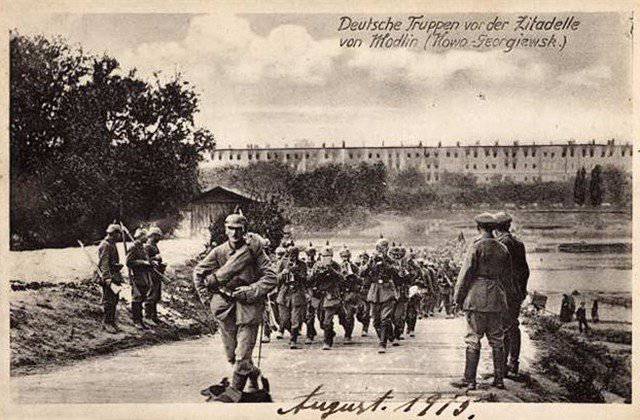
Russian fortresses against the German troops in 1915 year
The chain of powerful fortresses - Kovno (now Kaunas), Novogeorgievsk, Grodno, Osovets and Brest-Litovsk (now Brest) - was often pathetic in the patriotic press of Russia on the eve of the Great War “outpost of Russian bogatyrs”. Indeed, the chain of these powerful, fortified fortified strongholds blocked off, like an outpost on the watch, a western “entrance” to the borders of the Russian Empire. It was planned that with the start of the war with Germany unfavorable for Russia, this strategic outpost of powerful fortresses would contain the onslaught of the German troops, providing the necessary time for the deployment of the Russian armies.
The real events of 1915 of the year demonstrated that the task of prolonged containment of significant German forces by the potential of Russian fortresses was quite achievable. The brilliant defense of the fortress of Osovets, for example, convincingly demonstrated the high efficiency of a strong-willed, initiative, stable defense.
The negative experience of the hasty, senseless, even shameful capitulations of the Russian “warriors” testifies rather how flawed the personnel policy of the Russian military department was. The most important posts of commandants of strategically important strongholds were appointed, as a rule, by elderly, tired of service, people who had lost some volitional resource.
Kovna and Novogeorgievsk — remarkable fortresses that are very strong in military-technical terms — turned out to be the first among the “loyal staffs” of the Russian strongholds.
Forces and facilities of Kovna fortress
The Kovno citadel (before the revolution, this city was often called Kovna), located in the eastern part of Lithuania on the Neman River, was one of the relatively new fortresses. Construction work on the first general plan of the fortress began in 1882 and envisaged the construction of 7 forts and 9 batteries, a fortified closed fence, casemates, barracks, and administrative buildings. Kovnu several times tried to expand and strengthen 1904-1905, especially after the Russian-Japanese war, taking into account the experience of the defense of Port Arthur.
In 1912, a new citadel expansion plan was approved. Kovna was included in the line of powerful western fortresses - along with the new fortress of Grodno (the outdated name of Grodno) and strengthened in fortification by Novogeorgiy and Brest-Litovsk. The expansion of the Kovno stronghold provided for the construction of 12 new forts and 9 strongholds at a distance of 4 km from the old forts. The length of its outer contour increased from 30 to 45 km.
Work on the modernization of Kovna began in the 1913 year and in part of the primary device was completed by the winter of 1914. At the beginning of the war in Kovno fortress it was stationed 28-Infantry Division (109-th Volzhsky, 110-th Kama, 111-th Don, 112-th Ural infantry regiments), and 3-th Novorossiisk Dragoons and 6-th Don Cossack regiment.
The 1914 offensive operations of the year required all forces, and these units were sent to the front. To the Germans' approach in the summer of 1915, Kovna was defended by reserve units — 495-th Kovensky and 496-th Wilkomir infantry regiments, as well as 102-th reservist militia brigade. The forces of the citadel reached 55 thousands of bayonets, which was quite enough for effective defense. The commander of the fortress from March 1909 was General of cavalry Vladimir Nikolaevich Grigoriev.
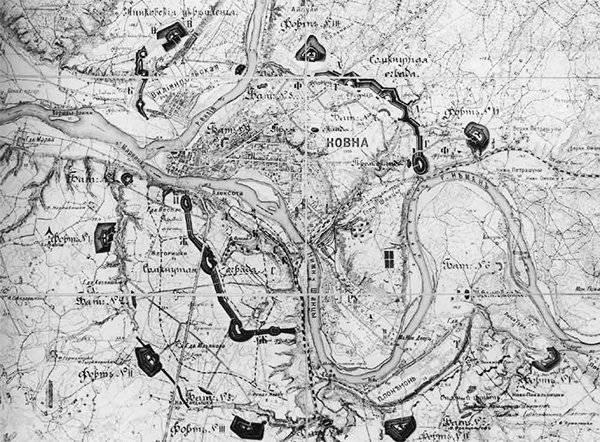
Kovna had a solid armament: 45 heavy machine guns "Maxim" and 1375 guns of 16 types. Among the artillery systems there were four especially powerful (280-mm and 254-mm) guns, 67 pcs. 8-inch (203-mm) howitzers and 118 pcs. 6-inch (152-mm) guns, as well as 315 regiment guns (107-mm and 106-mm). The range of 280-mm mortars was about 10 km, with 58,6 kg of explosives cast in one projectile. The range of 254-mm serf guns was significantly higher - 20,5 km, when a 18,8 kg of explosives was dropped in one projectile. The six-inch (152-mm) guns from Cane allowed to confidently destroy the enemy at a distance of about 12 km.
Kovna had her own aviation detachment: 16 aircraft Farman-XXII and Voisin.
Without hardness, calm and energy
The attack on the Kovno fortress developed under the strategic plan of Field Marshal Paul von Hindenburg around the encirclement of Russian troops in the so-called “Polish ledge”.
30 July 1915 two divisions with auxiliary units from the 40 Corps 10 of the German army under the command of General Karl Litzmann began to deploy on a bridgehead between the Neman and Yesia rivers - on a wooded and swampy bridgehead with extremely poor roads. General Litsman consciously risked - all along the Kovno storm the right (southern) flank of his grouping remained virtually unprotected.
“Kovna’s attack was hampered by a lack of heavy mounted fire,” wrote Karl Litzman in his memoirs, “those funds that the high command provided us at the end of July were sent under Novogeorgiyevsk. We had only a few batteries of heavy calibers that could operate only from the railway and had a short range. But we did not stop any difficulties - we laid the necessary branches on the virgin soil. The attack could be made only on the section between the railway Verzhbolovo-Kovna and the river Neman. The right wing of the attack was all the time under a strong Russian threat, and this threat grew as we moved forward. ”
8 August, the Germans began a systematic bombardment of the fortress, on the same day the Big Burt, a unique 420-mm mortar, named after Bertha Krupp, the granddaughter of Germany’s steel and gun king Alfred Krupp, was brought to combat positions. The high-explosive “Big Bertha” projectile with a weight of 900 kg flew 14 km and left a hopper with a depth of 4,25 meters and a diameter of 10,5 meters at break. From the armor-piercing projectiles "Bertha" could save only reinforced concrete floors with a thickness of more than 3,5 meters.
The next day, the Germans raised the Guards infantry to storm: the onslaught was so strong that a combined detachment of border guards and militias of the 2 and 7 of the Koven squadrons (about 500 people) were forced to retreat. However, in the early morning of July 28, the same detachment returned to its former positions in a terrible hand-to-hand combat. Only 72 of the person remained alive from the whole detachment.
On July 28, the Supreme Commander, Grand Duke Nikolai Nikolayevich sent a remarkable telegram to Commandant Kovna: “I am sure that the garrison of the fortress will defend it with honor and will repel assaults with the help of God. I firmly hope that you will show the necessary firmness, calm and energy and, when necessary, will support the heroic spirit in the troops of the garrison when necessary. ”
Why Glavkoverhukh needed to unequivocally remind the already elderly general, who had previously been the commandant of the glorified Sevastopol fortress, about the need to maintain "firmness and calm" - remains a mystery. It is likely that the telegrams that were sent by General Grigoriev to the front headquarters and the Headquarters, gave reason to doubt his attitude.
Napoleon Bonaparte has a very correct observation: “A fortress that is not taken in the first three days of the assault is better not to take at all.” Indeed, in the following days, the element of surprise does not work anymore, the besieged are getting used to the breaks and moans of the wounded, the losses of the assault units are growing rapidly, and resistant defenders are becoming more and more convinced of the effectiveness of their defense.
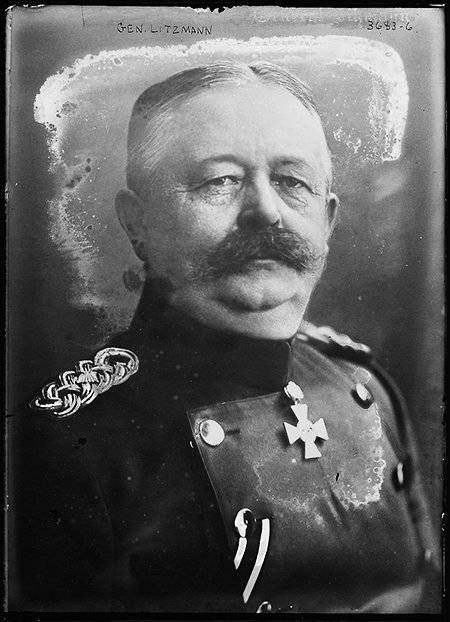
For seven days - from 8 to 14 of August - the Germans had no success at the walls of Kovny. Their advance is extinguished in a massive rifle-machine-gun-gun fire besieged. The configuration of the Russian-German front helped the Kovna garrison very much - the soldiers of General Litzman could only advance from one direction.
It seemed that the defense of Kovna was developing successfully: the Germans could not even take the outer line of the citadel in a week. Suddenly, for some 12-14 hours, a radical change sets in - the Germans consistently seize the Januce folvark and the reinforced Germananishkes line (on 13.00 1 in August), and then, in 16.30, break into the external line of defense. By the night of August 2, the entire first (external) line of the Kovna defense is in German hands.
Given the undoubted courage and perseverance of Russian soldiers (for example, on the 3 of August in the consolidated subdivision of Major General AK Krenke 9 thousands of people out of 6 thousands), it is hard to believe that such rapid success of the Germans is due only to the predominance of German forces and means. It can be assumed that during the defense of Kovna, the same situation took place that happened once in Port Arthur after the death of General R.I. Kondratenko: the rapid demoralization of the high command, which caused the rapid collapse of command and control.
Old men are rarely heroes.
Studies in the field of military psychology (the results of which were already available at the beginning of the twentieth century) convincingly prove: with each passing year, a person is increasingly afraid of death. Of course, there are exceptions, but these are few. As it seems, the General Staff of Russia made a huge mistake, leaving 64-year-old General Grigoriev at the highest post of the citadel, which was burned in the enemy artillery fire.
According to eyewitnesses, on the night of August 3, he repeatedly fainted from the burning of powder gases. Next to him stood the soldiers, the staff officer — they did not lose consciousness, and the commander lay in a swoon. What could be the effectiveness of defense management in such conditions?
The central internal bypass of Kovna could be held for at least several more days. On the night of August 3, Captain Vasily Beeman and his battalion with an unexpected counterattack knock the Germans out of Fort No.1. It would seem that the defense of the citadel can still be restored, at least by the internal contour of Kovny. But in vain - the central defense management is almost interrupted: some forts continue to stand to death, but without support and interaction with each other.
In the afternoon of August 3, General Grigoriev was unexpectedly not at the battle post in the citadel. Later he will tell military investigators that he went "for reinforcement." Why the commandant did not send one of the officers for this purpose and why he did not transfer the command to his deputy — it remains a mystery.
General Grigoriev showed up around 23.00 on August 3 in the village of Vladykino - 12 versts from the citadel. This fact overwhelmed even the bottomless bowl of patience of Themis of the Russian Empire: by the decision of the Dvinsky Military District Court, Grigoriev was torn off and epaulets were sentenced to years of hard labor for 15.
On the night of August 10, the commander of the 4 Army, General Yevgeny Radkevich, appointed the commander of the 124 Infantry Division, N.Ya. Lopushansky. It was already impossible to restore the central command in the citadel, but General Lopushansky was able to hold out for two more days and brought about 18 thousand soldiers from the fortress. The direct losses of Russians killed and prisoners exceeded 30 thousands of people.
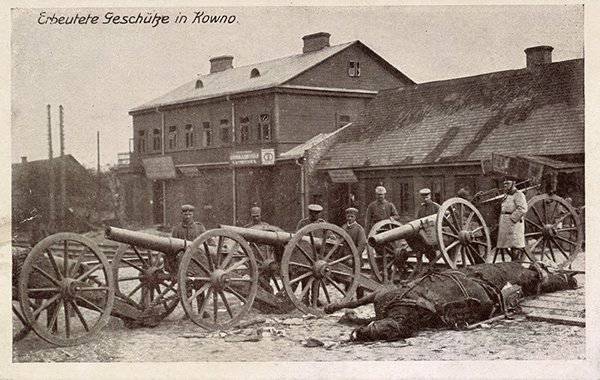
According to the testimony of German witnesses, the soldiers of General Litsman collected about 15 thousands of bodies of Russian soldiers in the Kovno fortress. They were brought to Kovno to the Resurrection Orthodox Cathedral and put in a huge mass grave. In accordance with the German military traditions, a modest stone monument was erected at the grave, which was destroyed by Soviet political workers in 1946 year. Now this place is not even a memorial plaque.
Fortress Novogeorgievsk
The encyclopedic dictionary of Brockhaus and Efron at the turn of the twentieth century reported the fortress Novogeorgievsk the following: “The triple row of walls of the citadel, wide and deep moats, high ramparts, lined with huge tools, give the impression of inaccessibility; for the siege of Novogeorgievsk, the enemy would need at least 200 thousands of troops, while 12 thousands are enough to defend it. ”
Modern defense researchers Novogeorgievska IM Afonasenko and Yu.A. Bakhurin notes that by the 1914 year, "the defensive power of the fortress had increased significantly, and the judgments of venerable military experts virtually ruled out doubts about the inaccessibility of this largest stronghold of the Old World."
Novogeorgievsk represented the construction of incredible power: in fact, it was not even a fortress, but a huge system of impregnable forts connected by highway and railway communications, fenced around the perimeter with ramparts and moats. Outside the perimeter of Novogeorgievsk, an entire army could freely accommodate.
The artillery potential of the fortress was enormous: only 8-inch (203-mm) guns numbered 59 shafts, 6-inch (152-mm) 359 (in Kovne was 315). By the total number of artillery barrels - 1814 units - Novogeorgievsk also exceeded Kovna.
By the time the German troops approached, considerable forces were concentrated in the fortress: the 58-I, 63-I, 114-I and 119-I infantry divisions, with a total strength of about 92 thousand bayonets. In the special literature it is sometimes said that these troops were, allegedly, not fired upon and did not have time before the assault how the fortification features of Novogeorgievsk should be understood. But one can doubt this: the 58-I and 63-I divisions were transferred to the citadel from the South-Western Front, and they were in the fortress (before the Germans arrived) more than 1,5 months. With effective command, this would be more than enough, not only for proper familiarization, but also for training troops.
The main problem of Novogeorgievsk was the personal qualities of top commanders, first of all, the commandant of the citadel, the cavalry general Nikolai Pavlovich Bobyr.
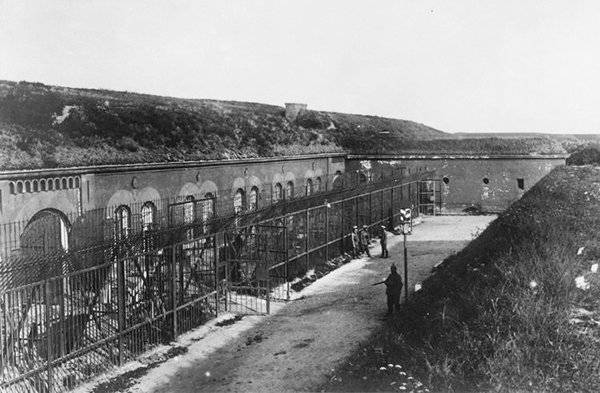
The commandant of Novogeorgievsk in 1915 had already been 61 for the year, it was an obese, apathetic man, prone to heavy feasts and cheap window dressing, the soldiers gave him a remarkable nickname “Bubble”. Bobyr practically had no combat experience; instead of field exercises and artillery firing, he preferred to work at the writing desk, for his research in the distant 1887 year in East Sayan he had a reputation as an "orientalist." Commanding qualities of NPBabyr also, apparently, were doubtful. General Denikin, in his "Outlines of the Russian Distemper," is a very telling example when the commandant of Novogeorgievsk, checking the soldiers' performance, ordered them to prick the inspectors with bayonets - in several cases this insane order almost led to the tragedy.
Under the commandant was the chief of staff of the citadel - General N.I.Globachev. All military contemporaries, who saw him in the case, described this officer as a “complete nothingness”, unable not only to organize the troops, but also to cope with his own horse.
"Russian business trip" by Colonel-General Beseler
The German General Staff regarded Novogeorgievsk as a very “tough nut”. Having learned from the interpretations of the Russian radiograms that the fortress was supposed to be defended in complete surroundings for at least six months, the Germans began to prepare for the storming of the citadel with special care.
A special siege army "Modlin" was created, which included the 14-th Landwehr Division (formed from reservists - RP) and the infantry corps of General Gustav von Dikhut. Later, the reserve brigade of General von Pfeil, as well as the 21-I and 169-I Landwehr Brigades, was included in the 45 infantry battalion.
Artillery fist of the "Modlin" consisted of 84 guns of heavy artillery six 420-millimeter and nine 305-millimeter howitzers, one long-barreled 150-mm gun, two 210-mm mortirnyh battery, 11 batteries of heavy field howitzers and three batteries of heavy field guns caliber from 100 to 150 mm. The main striking force of the German fire hammer was, of course, the Big Burt's 420-mm howitzer. These guns successfully combined a high destructive potential with a good rate of fire, with a unique mobility class for guns of such a heavy class.
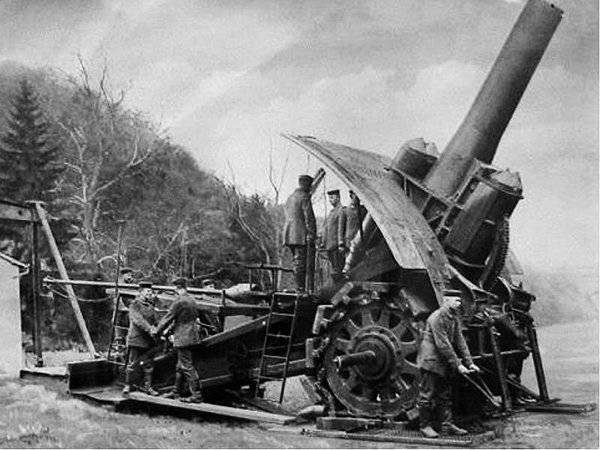
It is important to emphasize that neither by the number of troops, nor by their combat proficiency (mainly parts of the Landwehr, i.e. military units of the 2 line), nor even by the number and firepower of artillery, did the siege army "Modlin" irresistible force. According to the well-established practice, the German General Staff tried to ensure the seizure of Novgeorgievsk not by concentration of unlimited forces and means, but by a qualitative, strong-willed, to some extent, even innovative command.
The commander of the siege army was appointed Hans Hartwig von Bezeler - Inspector General of the fortifications of Germany, a specialist of the highest class. In total for 12 days - from September 28 to October 10 1914, commanding on the Western Front a special army group "Bezeler", he managed to capture one of the strongest fortresses of Europe - Antwerp from Belgium. General Bezaler, despite his venerable age (65 years), struck contemporaries with boiling energy, keen mind, habit of inspecting personally, not trusting paper plans, fortifications.
"Gift" of Colonel Korotkevich
6 August 1915, German troops reached the Narew River and immediately began to cross over to the east bank - a “moment of truth” arrived for the fortress of Novogeorgievsk. “The headquarters of the North-Western Front had to decide the question: what to do with the strongest Russian fortress - Novogeorgievsky? - writes the military historian Anton Kersnovsky, - the Russian armies were to go a long way, the fortress’s revenues could no longer be considered - its garrison was doomed to death. Putting to defend the lost, with the withdrawal of the 1 and 2 armies, every value of the fortress, the headquarters of the North-Western Front locked it in the right and senseless death of almost 100 000 troops.
In the light of the rapid death of Novogeorgievsk, the emotional intensity of Kersnovsky seems to be justified. But how should the decision of the commander of the North-Western Front, MV Alekseev, be regarded if the defense of Novogeorgievsk continued for the month of 2-3 (not to mention the months that were planned for 6)? Perhaps then, having detained the German troops and loosening the "onslaught on the East", would the defense of Novogeorgievsk deserve a different assessment?
On August 18, the Germans seized Novogeorgievsk from the south and began shelling Dembe and Zegrzh forts. The garrison troops, concentrating the available forces on the outer perimeter of the fortress, retreated across the Narew River on the night of August 7. “Everything is going well: the environment of Novgeorgiyevsk is almost complete,” wrote one of the officers of the headquarters of the German Eastern Front, M. Goffman, in an 7 in August.
The retreating troops of the Russian North-Western Front, as well as the troops of the garrison of Novogeorgievsk, behaved passively, practically accepting the transition of the initiative into the hands of the Germans. As a result of the "non-resistance" of the Russian troops, the 169-Brigade of the Landwehr - from the south, the 21-Brigade of the Landwehr and the Brigade of General Pfeil - from the northeast, the 14-I division of the Landwehr and the corps of General Dikhut - from the North-West, closed the 10 in August around Novogeorgievsk ring environment.
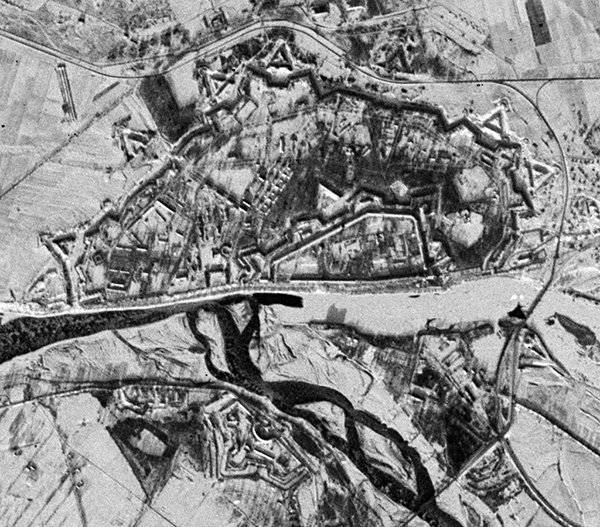
This allowed General Bezeler to abandon the methodical siege and risk to take a fortress with a decisive attack in one narrow sector, but with the involvement of heavy and extra heavy guns. The success of this plan contributed to the familiarity of Beseler with all the features of the fortification of Novogeorgievsk. 17 July 1915 of the year German intelligence took the inspection team of the engineering part of the fortress by surprise, which without a cover made a detour of fortifications. As a result of the transient battle, the chief engineer of Novogeorgievsk, Colonel Korotkevich-Nochevny was killed, and his briefcase with the master plan of all the fortifications of Novogeorgiyevsk, including the layout of the heavy batteries, was on the desktop of the Modlin Army Commander.
The general scheme of capture by the Germans of Novogeorgievsk was almost exactly the same as in the case of Kovno.
The first stage of this scheme: the unsuccessful German onslaught during the 5-6 days, which invariably broke up in advanced positions, but at the same time caused all the deepening pessimism and loss of faith in their forces at the headquarters of the citadel. At the second stage, this led to the collapse of the tactical command in the fortress and the surrender of the first defensive line and nodal forts. Then a decisive storming by the Germans of the inner circle of the citadel followed logically, which led to a situation of growing chaos and a strange mixture of desperate heroism and equally desperate cowardice in different divisions. Capitulation in these conditions occurred through the 1-2 of the day.
Defense "in commandant"
The sector of the main attack, which was chosen by General Bezaler, was located between the rivers Vkra and Narev. He actually had no alternative: it was only here that the railway line passed, which ensured the supply of almost 900-kilogram shells to the Big Burt.
The Germans began shelling the sector of the future breakthrough from 12 August, day by day increasing the intensity of the bombing. The apogee of the first phase of the assault came on August 16-17: the shelling of Russian positions reached its maximum strength, the German Landwehr fiercely rushed to the assault of the external bypass, but was invariably rejected by the Russian soldiers.
Only at the end of the day on August 17 at the cost of significant losses, the Germans managed to capture only two forts from 33, and the fate of one of them was unclear, as the Russians continued to fight back in the lower casemates.
“The ever-growing power of shelling,” notes I.M. Afonasenko and Yu.A. Bakhurin, - did not cause significant harm to the Russian casemate fortifications, and it is likely that if even the passive defense of the northeastern fort groups continued, the Bezeller headquarters would have to reconsider the tactics of the accelerated attack. The fate of Novogeorgievsk largely depended on the decision that the commandant was supposed to take. It turned out to be fatal. ”
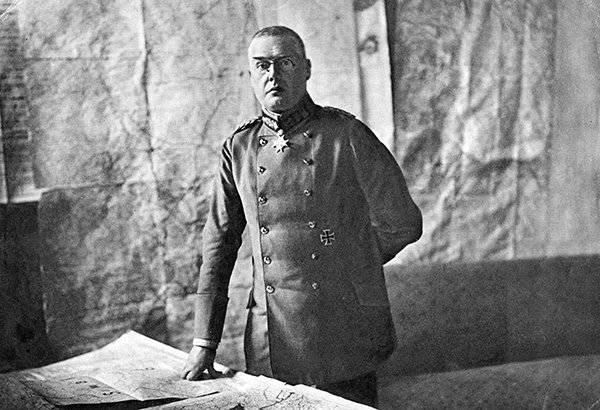
The second phase of the defense was “under commandment”: the phase of unmotivated pessimism and cowardice. On the night of August 18, having reflected the enemy in almost all sectors, General N.P. Boby gave the order to retreat from the fort groups XV and XVI. In fact, this meant the criminal surrender of the external circuit of the fortress. Guided by the officer's honor and the laws of wartime, the officers of the headquarters of Bubble should, at best, arrest him immediately. Such conversations among the officers of the fortress were conducted, but ended only with the adoption of the next glass "on the chest."
Following the order of N.P. At a loss, the Russian troops meaninglessly left the 5 forts right away and retreated to the internal line of defense, and it became impossible to eliminate the gap that had appeared in the outer contour. Moreover, from the internal roundabout, Russian troops were deprived of the opportunity to organize defense at an intermediate position based on the banks of the Vkra river. The German troops, on the contrary, felt the closeness of the victory: the gunners had the opportunity to transfer fire to the central forts of Novogeorgievsk, and the Landwehr acquired bridgeheads for further offensive. A wave of rumors of treason rolled over the fortress, the fighting spirit of the garrison fell.
To avoid "further bloodshed"
The head of the operational management of the headquarters of the German Eastern Front, General M. Goffan, upon learning of the seizure of the outer circuit of the fortress, wrote 18 in August in a diary: “If Novogeorgievsk falls in the coming days, we will receive three free divisions at once. In this case, the situation on the front will generally improve significantly. "
Early in the morning of August 18, General Bezaler gave his commanders an order to actively imitate preparations for the assault from all sides. The sky fell on General Bobyr at once: the craven "Orientalist" felt like a hare surrounded by hounds of dogs. Already at the end of the day, the commandant of Novogeorgievsk ordered the withdrawal of Russian troops from the X-XIII fort groups. This decision actually doomed the fortress to surrender.
The infantry corps of General Dikhut at dawn on August 19 gratefully accepted this "gift." The Saxons, without losing a single soldier, immediately occupied the 10 forts - the outer perimeter of the fortress passed into the hands of the Germans. By noon, General Dikhut began to assault the internal defensive line of Novogeorgievsk.
Behind the inner contour of the fortress, meanwhile, the psychosis of defeatism was emerging on a new spiral. Crowds of soldiers, retreating from the outer forts, wandered aimlessly around the inner perimeter of the citadel - no one organized them or tried to use them in defense. It seemed that the staff officers competed with each other in only one thing: who would call a closer date of surrender. Early in the morning of August 19, the fortress squadron was ordered to take regimental flags on airplanes to the Russian rear. Airplanes took off, and it was possible to surrender "with a clear conscience."
Russian troops began to surrender in battalion, the degree of their demoralization was such that the Germans did not even take weapon: the dreary columns of Russian soldiers with rifles on their shoulders walked into the German rear and already there they were handed over. The central fort (third) of the inner circuit was captured by the Germans for 4 hours, and the adjacent fort II was captured in just 2 hours.
By the evening of August 19, General Bobyr ordered to gather troops in the central square of the citadel and surrender their weapons. Of the crowd of many thousands, only five officers — Fedorenko, Stefanov, Ber, and Berg (unfortunately, did not keep the name of the fifth officer story) refused to execute the next criminal order. It is curious that two of these heroes - Ber and Berg - were Russified Germans, Fedorenko - a Ukrainian, and the surname Stefanov equally belonged to a Russian, Belarusian, or Bulgarian.
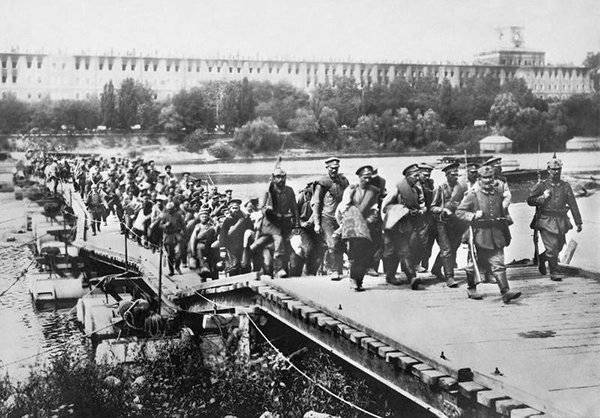
On the night of August 20, these five heroes left the fortress and, after successfully passing through a loose German environment, through the 18 days they fought their battles in their area of Minsk. God loves the brave!
On the same night, General Bobyr ran over to the Germans. Sitting in the dining room of the headquarters of General von Beseler (the German commander did not even consider accepting this nothingness), he dictated an orderly ordering the surrender of the fortress, motivated, of course, by the reluctance of "further bloodshed."
In the evening of August 20, Kaiser Wilhelm II himself arrived in Novogeorgievsk. The next day, a small military parade was held in the fortress. At the same time, according to the testimony of an American correspondent, “a column of Russian prisoners leaving the fortress stretched to the horizon with a dirty brown line.” William II in the evening of August 21 telegraphed the Greek Queen about the results of the assault: 90 thousands of Russian soldiers were taken prisoner, and the trophy team counted 1500 guns.
Modern military historians have calculated that the total losses of the Russian army killed and captured in Novogeorgievsk amounted to 90 214 soldiers and 1 027 officers (of which 23 is general). This is 1,4 times the total amount of casualties by prisoners for the entire period of the Russian-Japanese war 1904-1905.
General Nikolai Bobyr spent the entire period of the Great War in German captivity. The Brest-Litovsk peace treaty between Bolshevik Russia and Germany allowed Bobir to move to the Crimea. In Yalta, after the evacuation of the Russian army by General Wrangel, he was arrested by the Chekists and executed during the massacres of Russian soldiers and officers in the period 7 December 1920 of the year 25 in March 1921. Sitting in the crowded dirty basement of the VChK, the former commander of Novogeorgiyevsk probably thought more than once with anguish: was it really worth keeping 19 August 1915 of his year, a very middle-aged life for such a further fate?
Information